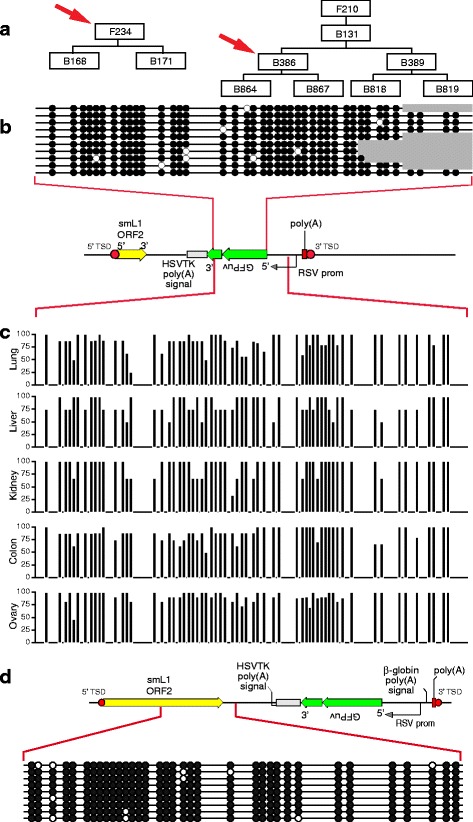Fig. 6.

De novo silencing of somatic L1 insertions by dense cytosine methylation during embryogenesis. We evaluated cytosine methylation at new L1 insertions genome-wide by performing bisulfite sequencing. a Pedigrees of (left) pseudofounder mice F235 and F234, and (right) offspring mouse B386 (red arrows). At least some of the de novo L1 integrants initially integrated in pseudofounder mice, despite the absence of the L1 donor, were transmitted to their offspring. b Dense de novo methylation at a new L1 insertion in pseudofounder mouse F235, revealed by bisulfite sequencing using primers DES2219 x DES2221 (Additional file 1: Table S1). Each row represents an individual sequence read. Filled circles, methylcytosines; open circles, unmethylated cytosines. Gray shading, right: sequence data not available. Bottom: Schematic of de novo L1 integrant. Cytosine methylation within the spliced GFPuv reporter gene was assayed (red connecting lines). Other integrants at independent genomic loci also may have been assayed by the same amplicons. c Dense de novo methylation in various somatic tissues (left) in pseudofounder mouse F234, including lung, liver, kidney, colon and ovary, using the PCR amplicon DES2219 x DES2221. Data are presented as cumulative percentages methylated (y-axis) for 61 CpG dinuceotides at the indicated positions in genomic template DNA (x-axis). d Dense cytosine methylation at a new L1 insertion (schematic, top), initially identified in founder mouse F210, which was transmitted through the germ line to its offspring. Tail tissue from progeny mouse B386 (panel A, right, red arrow) was assayed using primers DES2016 x DES2018
